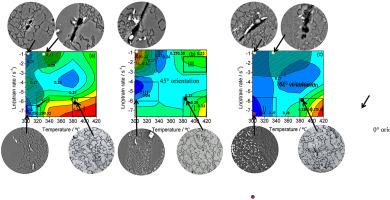当前位置:
X-MOL 学术
›
J. Alloys Compd.
›
论文详情
Our official English website, www.x-mol.net, welcomes your
feedback! (Note: you will need to create a separate account there.)
Processing maps of extruded AZ80+0.4% Ce magnesium alloy
Journal of Alloys and Compounds ( IF 5.8 ) Pub Date : 2020-12-01 , DOI: 10.1016/j.jallcom.2020.156064 Yongbiao Yang , Qingfeng Qin , Zhimin Zhang , Qiang Wang , Mu Meng , Min-jie Liang , Henry Hu
Journal of Alloys and Compounds ( IF 5.8 ) Pub Date : 2020-12-01 , DOI: 10.1016/j.jallcom.2020.156064 Yongbiao Yang , Qingfeng Qin , Zhimin Zhang , Qiang Wang , Mu Meng , Min-jie Liang , Henry Hu

|
Abstract Hot deformation behaviors of the extruded AZ80 + 0.4% Ce magnesium alloy plate were investigated in the temperature range of 300–420 °C and strain rate range of 0.0005–0.5 s−1 by using a Gleeble 3500 thermal simulation test machine. The cylindrical specimens for hot compression tests were cut in 0°, 45° and 90° to the extruded direction of the plate, respectively. The microstructure analysis was carried out with optical microscopy (OM), X-ray diffractometry (XRD) and scanning electronic microscopy (SEM). The results showed that the flow stresses of the 0°, 45° and 90° specimens exhibited anisotropic behaviors, which weakened with increasing temperatures, strains, and decreasing strain rates. The processing maps of different specimens were calculated and analyzed according to the dynamic materials model. The optimized stability domains for all the three specimens were in the temperature range of 380–420 °C and strain rate range of 0.0005–0.005 s−1, while the instability domains varied with specimen orientations. The apparent activation energy of the 0°, 45° and 90° specimens were 154.45 kJ/mol, 129.16 kJ/mol and 145.97 kJ/mol, respectively, suggesting the change of deformation mechanisms with specimen orientations. The operation of different slip systems, which were indicated by the varying values of the Schmid factor, should be responsible for the anisotropic hot deformation behaviors for the extruded AZ80 + 0.4%Ce magnesium alloy plate with basal texture.
中文翻译:

挤压AZ80+0.4% Ce镁合金加工图
摘要 采用 Gleeble 3500 热模拟试验机,研究了挤压 AZ80 + 0.4% Ce 镁合金板在 300-420 °C 温度范围和 0.0005-0.5 s-1 应变速率范围内的热变形行为。用于热压缩试验的圆柱形试样分别与板材的挤压方向成 0°、45°和 90° 的角度切割。用光学显微镜 (OM)、X 射线衍射仪 (XRD) 和扫描电子显微镜 (SEM) 进行微观结构分析。结果表明,0°、45°和90°试样的流动应力表现出各向异性行为,随着温度、应变和应变速率的增加而减弱。根据动态材料模型计算和分析不同试样的加工图。所有三个试样的优化稳定性域都在 380-420 °C 的温度范围内和 0.0005-0.005 s-1 的应变速率范围内,而不稳定域随试样方向而变化。0°、45°和90°试样的表观活化能分别为154.45 kJ/mol、129.16 kJ/mol和145.97 kJ/mol,表明变形机制随试样取向而变化。不同滑移系统的运行,由施密德因子的变化值表示,应该是挤压具有基底织构的 AZ80 + 0.4%Ce 镁合金板的各向异性热变形行为的原因。0°、45°和90°试样的表观活化能分别为154.45 kJ/mol、129.16 kJ/mol和145.97 kJ/mol,表明变形机制随试样取向而变化。不同滑移系统的运行,由施密德因子的变化值表示,应该是挤压具有基底织构的 AZ80 + 0.4%Ce 镁合金板的各向异性热变形行为的原因。0°、45°和90°试样的表观活化能分别为154.45 kJ/mol、129.16 kJ/mol和145.97 kJ/mol,表明变形机制随试样取向而变化。不同滑移系统的运行,由施密德因子的变化值表示,应该是挤压具有基底织构的 AZ80 + 0.4%Ce 镁合金板的各向异性热变形行为的原因。
更新日期:2020-12-01
中文翻译:

挤压AZ80+0.4% Ce镁合金加工图
摘要 采用 Gleeble 3500 热模拟试验机,研究了挤压 AZ80 + 0.4% Ce 镁合金板在 300-420 °C 温度范围和 0.0005-0.5 s-1 应变速率范围内的热变形行为。用于热压缩试验的圆柱形试样分别与板材的挤压方向成 0°、45°和 90° 的角度切割。用光学显微镜 (OM)、X 射线衍射仪 (XRD) 和扫描电子显微镜 (SEM) 进行微观结构分析。结果表明,0°、45°和90°试样的流动应力表现出各向异性行为,随着温度、应变和应变速率的增加而减弱。根据动态材料模型计算和分析不同试样的加工图。所有三个试样的优化稳定性域都在 380-420 °C 的温度范围内和 0.0005-0.005 s-1 的应变速率范围内,而不稳定域随试样方向而变化。0°、45°和90°试样的表观活化能分别为154.45 kJ/mol、129.16 kJ/mol和145.97 kJ/mol,表明变形机制随试样取向而变化。不同滑移系统的运行,由施密德因子的变化值表示,应该是挤压具有基底织构的 AZ80 + 0.4%Ce 镁合金板的各向异性热变形行为的原因。0°、45°和90°试样的表观活化能分别为154.45 kJ/mol、129.16 kJ/mol和145.97 kJ/mol,表明变形机制随试样取向而变化。不同滑移系统的运行,由施密德因子的变化值表示,应该是挤压具有基底织构的 AZ80 + 0.4%Ce 镁合金板的各向异性热变形行为的原因。0°、45°和90°试样的表观活化能分别为154.45 kJ/mol、129.16 kJ/mol和145.97 kJ/mol,表明变形机制随试样取向而变化。不同滑移系统的运行,由施密德因子的变化值表示,应该是挤压具有基底织构的 AZ80 + 0.4%Ce 镁合金板的各向异性热变形行为的原因。











































 京公网安备 11010802027423号
京公网安备 11010802027423号